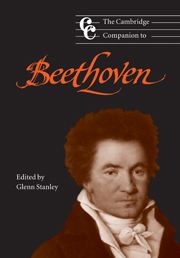Book contents
- Frontmatter
- Part I A professional portrait
- Part II Style and structure
- Part III Genres
- 7 The piano music: concertos, sonatas, variations, small forms
- 8 Beethoven's chamber music with piano: seeking unity in mixed sonorities
- 9 Manner, tone, and tendency in Beethoven's chamber music for strings
- 10 Sound and structure in Beethoven's orchestral music
- 11 Beethoven's songs and vocal style
- 12 Beethoven's essay in opera: historical, text-critical, and interpretative issues in Fidelio
- 13 Probing the sacred genres: Beethoven's religious songs, oratorio, and masses
- Part IV Reception
- Notes
- Selected further reading
- General index
- Index of Beethoven’s compositions and sketches
- Plate section
7 - The piano music: concertos, sonatas, variations, small forms
from Part III - Genres
Published online by Cambridge University Press: 28 September 2011
- Frontmatter
- Part I A professional portrait
- Part II Style and structure
- Part III Genres
- 7 The piano music: concertos, sonatas, variations, small forms
- 8 Beethoven's chamber music with piano: seeking unity in mixed sonorities
- 9 Manner, tone, and tendency in Beethoven's chamber music for strings
- 10 Sound and structure in Beethoven's orchestral music
- 11 Beethoven's songs and vocal style
- 12 Beethoven's essay in opera: historical, text-critical, and interpretative issues in Fidelio
- 13 Probing the sacred genres: Beethoven's religious songs, oratorio, and masses
- Part IV Reception
- Notes
- Selected further reading
- General index
- Index of Beethoven’s compositions and sketches
- Plate section
Summary
The piano represented a springboard for Beethoven's achievements and a primary vehicle for the pathbreaking innovations of his evolving musical style. His early reputation as a prodigy at Bonn rested on his playing of Bach's Well-Tempered Clavier, and his success at Vienna after 1792 was founded in no small measure on his ability to improvise at the keyboard. In assessing Beethoven's musical legacy for the piano, we should first consider the cultural context of his music and the relation of his works to his activities as a performing virtuoso. As some recent studies have emphasized, Beethoven's career coincided with and lent support to the rise of the notion of the autonomous musical artwork – the unique composition regarded as independent of specific conditions of performance. The fulfillment of Count Waldstein's famous prophecy made at Bonn “you shall receive Mozart's spirit from Haydn's hands” – as well as the fortification of Beethoven's style from earlier models, such as J. S. Bach, reflected the high cultural ambitions of his art as an indispensable basis for his originality. The negative tone of some early reviews of Beethoven's works sprang from perceptions of their challenging character and their overturning of conventions – reasons why a more thorough acquaintance based on repeated hearings was appropriate.
In evaluating this change in aesthetic reorientation, it is tempting but misleading to oppose the improvisatory tradition of Mozart and Beethoven as orators in tones with the growing recognition of autonomous works at the threshold of the nineteenth century. Important musical forms and procedures such as sonata designs, fugue, rondo and variations were established vehicles for extemporized performance. The performance context in private aristocratic salons is poorly documented, and public concerts of solo piano works hardly existed; yet the evidence available indicates that published solo works were often formalized versions of music originally presented as improvisation or fresh composition.
- Type
- Chapter
- Information
- The Cambridge Companion to Beethoven , pp. 103 - 126Publisher: Cambridge University PressPrint publication year: 2000
- 1
- Cited by



